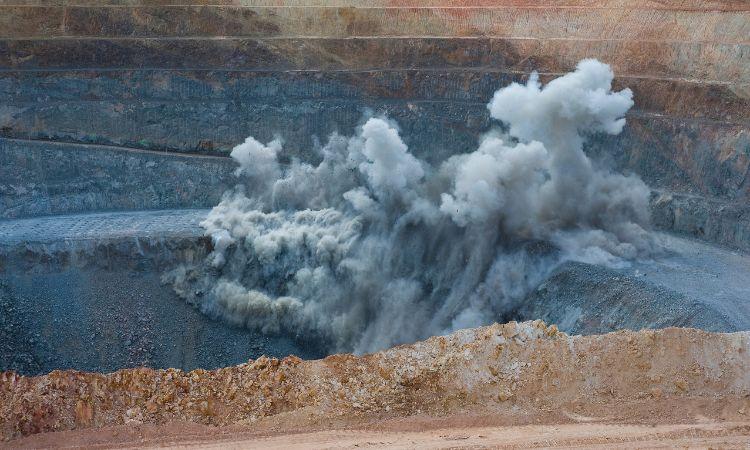The North America explosives market size is estimated to grow at a CAGR of 3.90% in the forecast period of 2024-2032. The major market drivers are the growing demand for explosives from end-use sectors such as construction, mining and quarrying, and military. Explosives have been an indispensable part of industries such as mining and quarrying, where their applications have revolutionized extraction processes. As we delve into the dynamic world of explosives and their pivotal role, we will explore how they are shaping North America's mining and quarrying sectors, their economic impact, safety and environmental concerns, and what the future holds in this explosive domain.
Explosives in Mining
In the heart of the mining industry, explosives play a pivotal role in the extraction of valuable minerals and ores. Here's how:
-
Breaking Down Rocks and Ores: Explosives are used to fragment hard rocks and ores into smaller, manageable pieces. This process is essential for efficient extraction and processing.
-
Types of Explosives: The explosives commonly used in mining include dynamite, ammonium nitrate fuel oil (ANFO), and emulsion explosives. Each type has specific applications and advantages depending on the mining operation.
-
Safety Precautions and Regulations: The use of explosives in mining is strictly regulated to ensure the safety of workers and surrounding communities. Rigorous safety measures and protocols are in place to prevent accidents and mitigate risks associated with handling explosives.
Explosives in Quarrying
The quarrying industry, which provides essential building materials such as stone, sand, and gravel, also relies heavily on explosives for its operations:
-
Extracting Building Materials: Explosives are used to break down large rock formations into smaller pieces, making it easier to extract valuable building materials. This process is crucial for meeting the demands of the construction industry.
-
Efficiency and Cost Reduction: The use of explosives in quarrying significantly increases efficiency and reduces costs. It allows for faster extraction and reduces the need for manual labor.
-
Environmental Considerations: Quarrying explosives can have environmental impacts, such as dust and noise pollution. Sustainable quarrying practices and technologies are being developed to minimize these effects.
Economic Impact
The mining and quarrying industries are substantial contributors to the North American economy, and explosives play a vital role in their success:
-
Economic Contribution: These industries provide employment opportunities and contribute significantly to regional and national economies. The extraction of minerals, metals, and building materials is essential for infrastructure development and manufacturing.
-
Employment Opportunities: Mining and quarrying operations create jobs across a wide range of skill levels, from miners and heavy machinery operators to geologists and engineers.
-
Explosives and Economic Growth: The use of explosives in these industries boosts economic growth by increasing productivity and facilitating resource extraction. This growth ripples through related sectors, including logistics and construction.
Environmental and Safety Concerns
While explosives are essential, their use in mining and quarrying comes with environmental and safety challenges:
-
Environmental Impact: The explosive fragmentation process can generate dust and release pollutants into the air and water. Efforts are ongoing to develop environmentally friendly explosives and improve containment measures.
-
Safety Challenges: Handling explosives requires stringent safety measures to protect workers and communities. Accidents can result in severe consequences, emphasizing the importance of safety protocols.
Sustainable Practices
In response to environmental concerns, the industry is adopting more sustainable practices:
-
Sustainable Mining and Quarrying: Companies are implementing sustainable mining and quarrying practices, including reclamation efforts to restore quarries to their natural state after extraction.
-
Alternatives to Traditional Explosives: Research is ongoing to develop alternative blasting technologies that reduce environmental impacts and enhance safety.
-
Initiatives for Reducing the Environmental Footprint: Industry associations and governments are collaborating on initiatives to minimize the environmental footprint of mining and quarrying operations.
Case Studies
Let's explore some real-world examples to see how explosives have been successfully utilized in mining and quarrying projects in North America:
-
The Bingham Canyon Mine: Located in Utah, this copper mine uses explosives to break down massive rock formations, making it one of the world's largest man-made excavation sites.
-
Graniteville Quarry: This Vermont quarry produces high-quality granite for construction. Explosives are employed to efficiently extract granite blocks used in buildings and monuments.
Future Trends
The explosives industry is continually evolving. Here are some emerging trends:
-
Advanced Blasting Techniques: Innovations in blasting techniques are increasing precision and reducing the environmental impact of explosions.
-
Digitalization: The use of data and digital technologies is enhancing the accuracy and safety of explosive operations.
-
Sustainability Initiatives: Industry leaders are investing in research to develop greener explosives and sustainable mining practices.
The Influence of Economic Factors
Beyond the intrinsic role of explosives in the mining and quarrying sectors, economic factors exert a considerable influence on the North American explosives market. These factors play a pivotal role in determining the industry's trajectory:
-
Market Demand: The overall demand for minerals, metals, and construction materials influences the demand for explosives. Economic growth and infrastructure development contribute to increased demand in these sectors.
-
Investment in Infrastructure: Government investments in infrastructure projects, such as roads, bridges, and buildings, have a direct impact on the demand for construction materials, further driving the explosives market.
-
Global Economic Trends: Economic conditions in North America and worldwide can affect commodity prices, which, in turn, impact mining and quarrying activities.
-
Resource Scarcity: Economic factors can drive exploration and extraction efforts, particularly when the scarcity of specific resources drives up their value.

